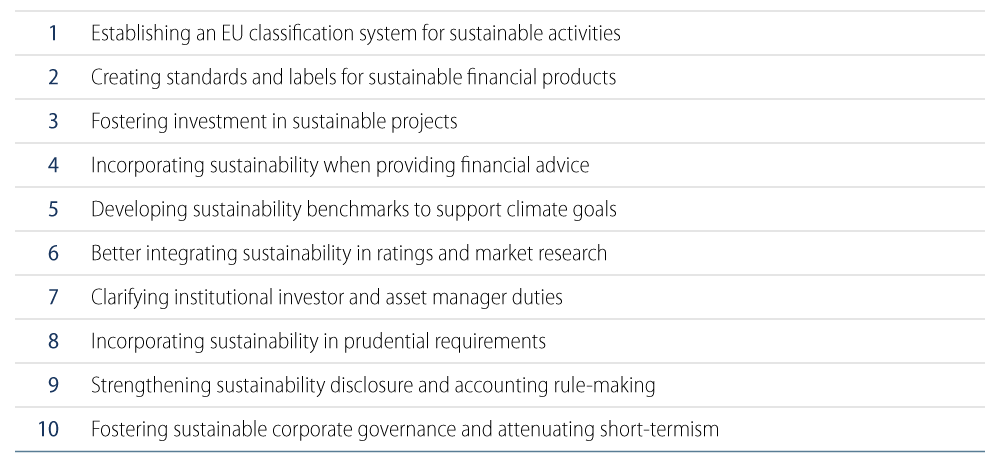In March 2018, the European Commission released its Action Plan on Sustainable Finance, an ambitious 10-point agenda designed to direct private capital toward the EU’s climate action and sustainability goals (see Exhibit 1). Progress on this Action Plan will be essential to the success of the European Green Deal announced last Wednesday, December 11, by newly elected EU President Ursula von der Leyen. Through the measures of this Green Deal, Europe intends to halve its greenhouse gas emissions by 2030 and achieve climate neutrality by 2050. The cost of reaching these goals is estimated at $321 billion (€290 billion) per year.
In recent days, key milestones have been reached on four of the objectives in the Action Plan:
- Action #1 – Establishing an EU classification system for sustainable activities: This week, all 28 EU member countries agreed upon a list of economic activities that qualify as environmentally sustainable for investment purposes. These activities contribute to climate change mitigation or adaptation, the sustainable use of water and marine resources, the transition to a circular economy, prevention and control of pollution, and preservation of ecosystems. The proposed taxonomy is expected to be approved by European Parliament on Wednesday, December 18, fully documented by 2021 and completely implemented by 2022.
- Actions #2 and 7 – Creating standards and labels for sustainable financial products, and clarifying institutional investor and asset manager duties: The EU approved on November 27 and published on December 9 disclosure regulations laying out specific investor reporting requirements, such as the degree to which both positive and negative sustainability factors are considered and the method for doing so, and periodic reports on how sustainability-labeled funds are meeting stated ESG objectives. Full implementation is required by March 10, 2021.
- Action #5 – Developing sustainability benchmarks to support climate goals: On December 9, the EU adopted the Low Carbon Benchmarks Regulation, which specifies requirements for climate transition (e.g., science-based decarbonization trajectories) and Paris-aligned benchmarks (e.g., the 1.5 degrees Celsius limit set in the Paris Climate Agreement) at the EU level. This regulation went into effect on December 10.
The development of these regulations provides support to European ESG investors, while accelerating ESG adoption by others who had been hesitant due to fiduciary or greenwashing concerns. Sustainability-related regulations in the UK have had a similar effect. There, pensions have been required to disclose their ESG approach and publish their stewardship policy since this past October, and must provide annual stewardship reporting by October 1, 2020. The UK Stewardship Code was likewise updated to explicitly incorporate ESG requirements on October 24, going into effect at the start of 2020.
While these regulations may appear daunting, we view this evolution to be largely beneficial for investors. We believe that providing more transparency is always positive, and that greater specificity in the realm of ESG helps investors to choose strategies that are aligned with their objectives. Drawing upon our experience creating investment solutions for ESG-focused clients, we are prepared to help investors address the new regulatory requirements, while putting their own unique values into financial practice.


